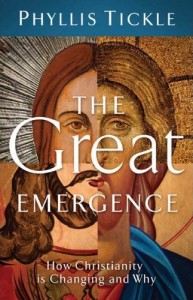
By Phyllis Tickle
Reviewed by Ann Niedringhaus
Writing Workshop Participant ’06
Baker, 165 pp., $17.99.
Why are many North American congregations either cemented in “horrendous certainty” or flailing around trying to fit into the culture at any cost? What will be the result of the current questioning of long-held theological concepts and creeds? Why are well-educated Americans often decidedly aggressive in their secularity or non-specific spirituality? Will the Christian church survive here, and, if so, what will it look like?
Phyllis Tickle offers multiple lenses through which to examine such questions. Founding editor of Publishers Weekly religion department, Tickle has become a self-described “sociologist of religion as it is commercially applied.” Her latest book is based on discussions with people across the United States—interviews conducted while she traveled as a popular speaker. The book’s central thesis is that North American Christianity is well into a needed transformation, which Tickle calls the “Great Emergence.” In this anxious time for the church, she offers reassurance: “When an overly institutionalized form of Christianity is, or ever has been, battered into pieces and opened to the air of the world around it, that faith-form has both itself spread and also enabled the spread of the young upstart that afflicted it.”
Scot McKnight calls The Great Emergence a book of “big theories.” It could also be called a brave book. When a writer lays out a broad array of influences, both historic and current, she makes herself vulnerable to critiques from experts in each of the areas she explores. Though it is likely that Tickle’s views can be and already have been attacked by professionals in every sector she summarizes, her book’s strength is in its very breadth. Readers will recognize the protean landscape she describes. They may feel relief in being able to say that this big picture is why it feels like such a difficult time to be Christian.
Tickle begins with her theory that we are decades into the fourth of Christianity’s every 500-year transformations. She calls such periods “giant rummage sales,” borrowing the term from Mark Dyer, an Anglican bishop. She supports her claim with a brief review of the major transitions that occurred around 500 and 1000 CE.
The Great Reformation of 1500-1600 CE receives a more detailed analysis, since it is an accessible, better-known era from which to explicate what purportedly happens every 500 years. One question is pivotal in each transformation, Tickle states: Where now is the authority? Post Reformation authority coalesced around “Scripture only and only Scripture.” A second key concept, the priesthood of all believers, helped make the authority of Scripture durable. When the invention of the printing press made universal literacy possible, these two doctrines could be widely implemented. Literacy and its results combined with many other revolutionary changes of the period. Transformation of culture and faith resulted.
Tickle uses a visual metaphor for the relationship between religion and culture: the cable of meaning. This simple metaphor illustrates her earlier statement that “religious enthusiasms in all holy rummage sales are unfailingly symptomatic or expressive of concomitant political, economic and social upheavals.”
The book’s final third turns to the Great Emergence itself, starting with its early roots, particularly in the development of 19th-century science. Tickle, who calls the 20th-century the “century of emergence,” then presents an extensive parade of more recent influences, such as Einstein’s theories, the search for the historical Jesus, Pentecostalism, Karl Marx’s ideas, organizations like Alcoholics Anonymous, the widespread use of recreational drugs, technological advances, and family reconfigurations.
The author concludes with a wide-ranging discussion of the future. She begins with diagrams of where North American Christianity has been and may be headed. These become increasingly speculative and ultimately disappear. Tickle then introduces concepts and processes such as orthonomy and theonomy, networked authority, center set approach, paradox, and de-Hellenization. When she revisits the pivotal question, “Where now is the authority?” her hope seems to lie in today’s conversations among emergent Christians who are influenced by Quaker approaches. Tickle concludes that the Great Emergence will result in “the theology, in part, of society’s reconfigured understanding of the self, the soul, the humanness of being in imago dei.”
On the book jacket Brian McLaren states that the Great Emergence “will shape the conversation among a wide range of Christians for years to come.” This may be the book’s greatest utility. It offers historic perspectives, theories of change, and speculations about the future for readers to chew on, add to, critique, or embrace as they observe the dizzying developments around them. It may also encourage people to explore more deeply the many influences here so briefly summarized. Chapter end notes refer readers to 13 works; references within the text offer more. A complete bibliography might have strengthened the book. However, this is not an academic text; rather, it is a starting point for most readers.
Tickle addresses many of our anxious questions. Her book is an engaging introduction to why and how Christianity is again changing into “a new, more vital form,” while “the Church also gains a grand refurbishment of the older one.” The book gives readers hope, surrounded though they are by myriad forces interacting in unexpected, even distressing, ways. It challenges them to participate in shaping what will emerge.
Ann Niedringhaus lives in Duluth, Minnesota. Ann attended the Collegeville Institute’s writing workshop Believing in Writing in 2006.
Like this post? Subscribe to have new posts sent to you by email the same day they are posted.



Leave a Reply